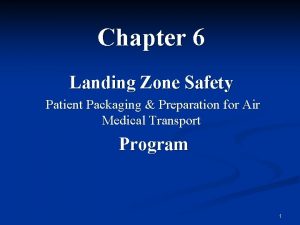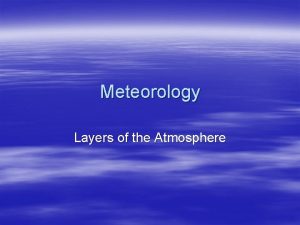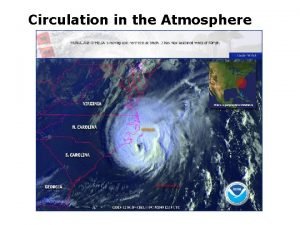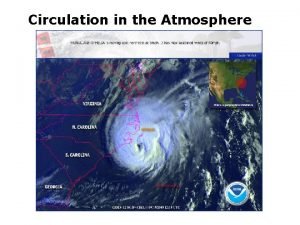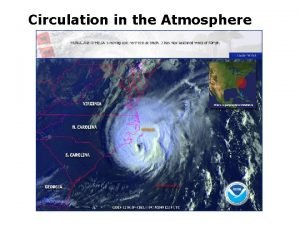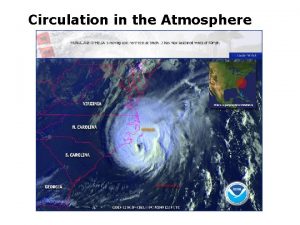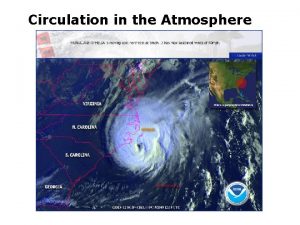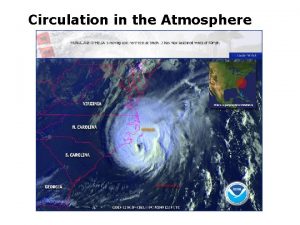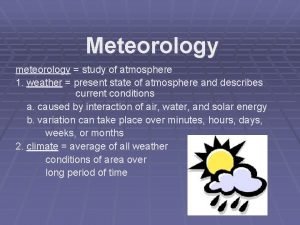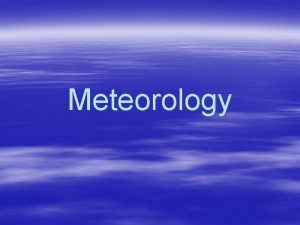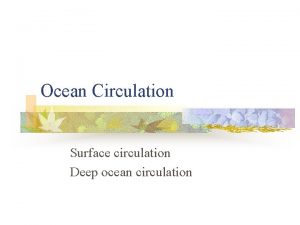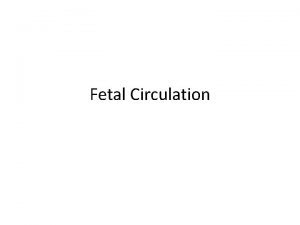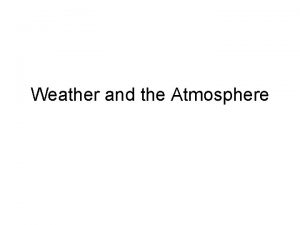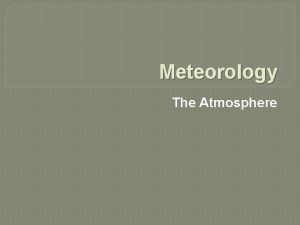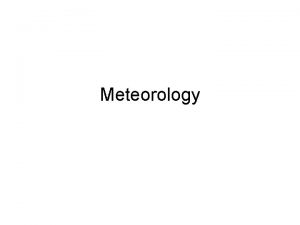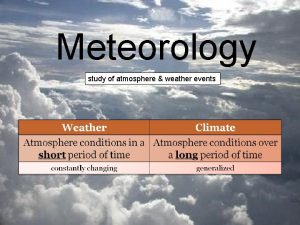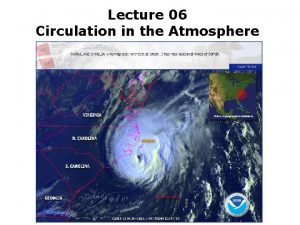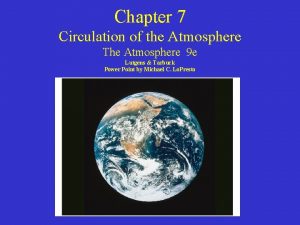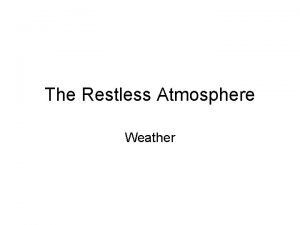Meteorology General Circulation General considerations on the atmosphere





















- Slides: 21

Meteorology: General Circulation • General considerations on the atmosphere • General atmospheric circulation • Meteorological regimes

Vertical Structure of the Atmosphere Pressure is the force per unit area due to the atmosphere: where P is pressure, z is altitude, ra is the air density, and g is the acceleration due to gravity; one assumes that the atmosphere is at hydrostatic equilibrium, that is to say that the vertical pressure gradient force compensates the gravitational force. Ideal gas law: where n is the number of moles, V is the volume of air, T is the temperature (in Kelvin), and R is the ideal gas law constant. If Mair is the average molar mass of air (~78% N 2 et ~21% O 2) : ra = n MMair/V, therefore: R = 8. 2 x 10 -5 m 3 atm K-1 mol-1 = 8. 314 J mole-1 K-1; MMair = 28. 8 g/mole ; g = 9. 81 m/s 2 d. P / dz = - ra g PV=n. RT P = ra R T / MMair

Vertical Structure of the Atmosphere Pressure Combining these two equations to eliminate ra, one obtains: One defines the “scaling height”, ha: and one integrates the atmospheric pressure equation as a function of altitude, z: where P 0 is the atmospheric pressure at the Earth’s surface. Actually, ha is not constant because T varies with altitude and the atmosphere is not exactly hydrostatic, therefore, the actual vertical profile differs slightly from that theoretical profile. d. P / dz = - P (g MMair) / (R T) ha = (R T) / (g MMair) P(z) = P 0 exp(- z / ha)

Vertical Structure of the Atmosphere Pressure At T = 250 K (an average value for the troposphere): ha = 7. 35 km, thus: P = 0. 37 atm at that altitude. At z = 15 km (~ tropopause): P = 0. 13 atm P(z) = P 0 exp(- z / ha) 1 atm = 105 Pa = 103 h. Pa = 1013 mbar = 760 mm Hg = 760 torrs

Vertical Structure of the Atmosphere Air Density According to the ideal gas law: P = ra R T / MMair Thus, for a given pressure, the air density is inversely proportional to temperature (in Kelvin). ra = P MMair / (R T) Therefore, warm air is lighter (less dense) than cold air.

Vertical Structure of the Atmosphere Average Temperature increases in the stratosphere: absorption of solar radiation by oxygen and ozone => photolysis and heat ~ -6. 5 K / km

General Atmospheric Circulation There is an excess of thermal energy in the tropics (due to evapotranspiration and the associated latent heat flux) and a deficit of thermal energy in the polar regions (due to snow and ice albedo). Therefore, there must be some transfer of heat from the equator toward the poles.

General Atmospheric Circulation The general atmospheric circulation results from: - Heat transfer from the equator toward the poles - The temperature inversion at the tropopause - The Earth’s rotation => the Coriolis force

General Atmospheric Circulation

Winds in the Free Troposphere The acceleration of an air parcel is proportional to the pressure gradient. Therefore, the wind results from a pressure difference between two locations: a steep pressure gradient leads to a strong wind due to the acceleration that results from that pressure gradient. The direction of the air flow is, in its simplest form, from the high pressure area toward the low pressure area. However, there are other forces (true or virtual) that affect wind direction.

Winds in the Free Troposphere The Coriolis Force The Coriolis force is a virtual force that results from the Earth’s rotation: it leads to a deviation to the right in the northern hemisphere and to the left in the southern hemisphere. It is zero at the equator and maximum at the poles.

Geostrophic Wind The Coriolis “force”, which is due to the Earth’s rotation, corresponds mathematically to a conversion from a universal georeferencing system to a local (Earth) georeferencing system. The force due to the pressure gradient must balance this Coriolis force, which leads to a change in the wind direction: this is called the geostrophic wind. LOW Isobars HIGH Pressure gradient force Coriolis force Wind direction

Geostrophic Wind Coriolis force Pressure gradient force where f is the Coriolis parameter (s-1), u and v are the components (in the x and y directions, respectively) of the geostrophic wind velocity, ra is the air density, and p is the atmospheric pressure.

Low Pressure System Therefore, in the northern hemisphere, the wind flows counterclockwise around a low pressure system (clockwise in the southern hemisphere) as the pressure gradient force balances the Coriolis force. L

High Pressure System Similarly, in the northern hemisphere, the wind flows clockwise around a high pressure system (counterclockwise in the southern hemisphere). H L H

Weather Systems Ideally, high pressure systems should be at 30 ° latitude due to downward motion of air masses of the Hadley cells (e. g. , Pacific and Bermuda semipermanent highs) and low pressure systems should be at the equator and at 60 ° latitude (e. g. , Aleutian and Icelandic semi-permanent lows). However, land masses and their heat budgets affect the pressure distribution, particularly in the northern hemisphere (where most continental areas are located). Therefore, low and high pressure systems evolve with time and location => weather.

Weather Regimes The meteorological scenarios that constitute the weather can be grouped in several “weather regimes” that share similar characteristics at the synoptic scale. For example, a representation using four meteorological regimes per season (i. e. , 16 weather regimes in total) can be used for Europe. The following figures summarize such a classification for the northern Atlantic Ocean and Europe for winter (December to February) and summer (June to August). These maps represent pressure anomalies compared to means calculated from meteorological data over the period 1950 -2008. The frequencies of each regime are indicated. Transition days lead to the change from one regime to the next. However, all regimes do not necessarily evolve into all other regimes.

Weather Regimes The meteorological regimes called “North Atlantic Oscillation” (NAO) correspond to variation in the atmospheric pressure between the Bermuda High (as measured in Lisbon) and the Icelandic Low (as measured in Reykjavik). The NAO+ regime corresponds to periods when the pressure difference between these two locations is greater than the mean and the NAO- regime corresponds to the opposite situation. The Atlantic Ridge regime corresponds to a high-pressure region (barometric ridge) that originates from the Bermuda High and spreads northward over the Atlantic Ocean. Similarly, the Atlantic Talweg regime corresponds to a low-pressure region (barometric valley) that originates from the Icelandic Low and spreads southward over the northern Atlantic Ocean. The blocking regimes correspond to meteorological conditions, which vary little during the period of the blocking regime.

Weather Regimes Winter weather regimes over the North Atlantic Source: E. Lecœur, 2013

Weather Regimes Summer weather regimes over the North Atlantic Source: E. Lecœur, 2013

Weather and Air Pollution High-pressure systems are associated with subsidence (downward air motion), calm conditions (low wind speeds), and clear skies (i. e. , sunshine). The combination of low wind speeds, little dispersion, and chemical transformations (due to sunlight) leads to increased air pollution. Low-pressure systems are associated with greater wind speeds and precipitation. The combination of strong horizontal winds, enhanced vertical dispersion, and scavenging of pollutants by rain leads to less air pollution.
 Single circulation and double circulation
Single circulation and double circulation Single circulation and double circulation
Single circulation and double circulation Bronchioles
Bronchioles What are the general considerations in machine design?
What are the general considerations in machine design? It is the general atmosphere created by the author's word
It is the general atmosphere created by the author's word Foreshadow
Foreshadow Bioreactor considerations for animal cell culture
Bioreactor considerations for animal cell culture Pre analytical considerations in phlebotomy
Pre analytical considerations in phlebotomy What is moral consideration in ethics
What is moral consideration in ethics Atm kiosk software
Atm kiosk software Slim cd inc
Slim cd inc Biopharmaceutic considerations in drug product design
Biopharmaceutic considerations in drug product design Eswl anesthesia considerations
Eswl anesthesia considerations Contrasting acquisition
Contrasting acquisition Types of costume design
Types of costume design Temperature regulation pdhpe
Temperature regulation pdhpe Collaboration design considerations
Collaboration design considerations Azure landing zone considerations
Azure landing zone considerations Design considerations for mobile computing
Design considerations for mobile computing Three considerations of societal marketing concept
Three considerations of societal marketing concept Ethical considerations examples
Ethical considerations examples Premylohyoid
Premylohyoid

















